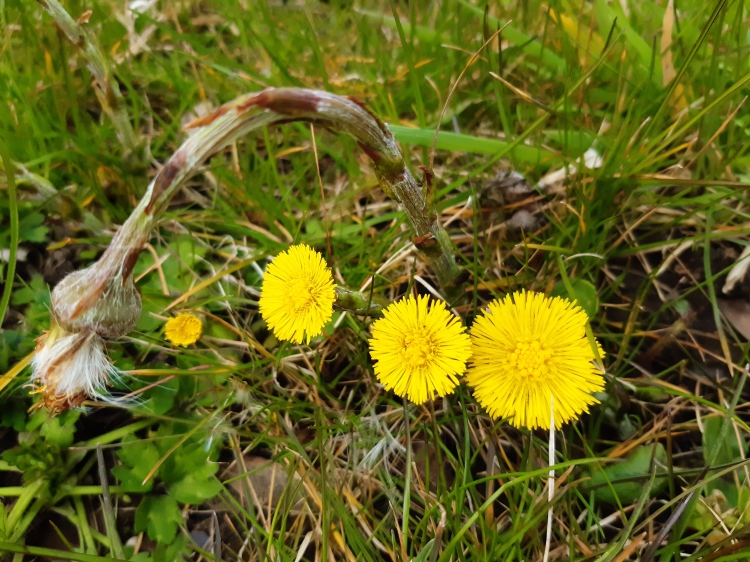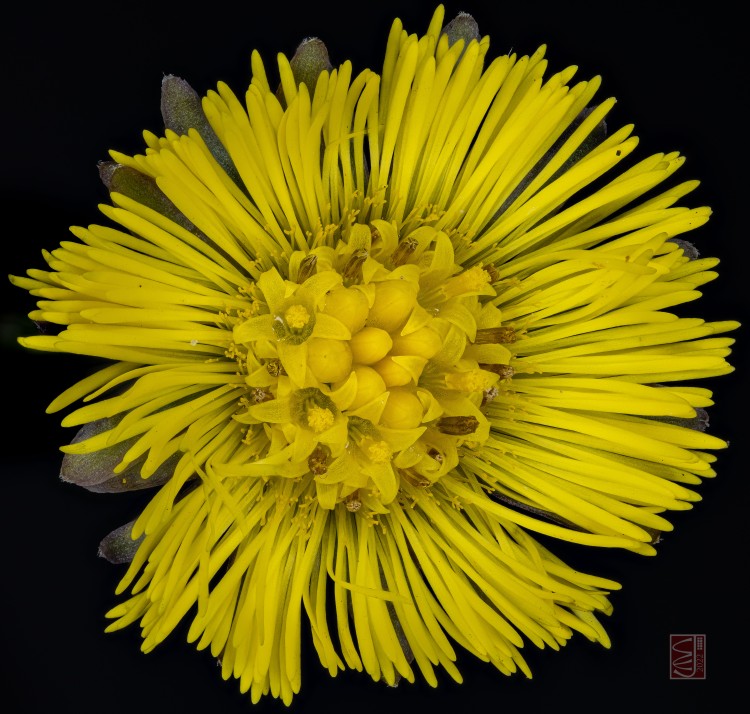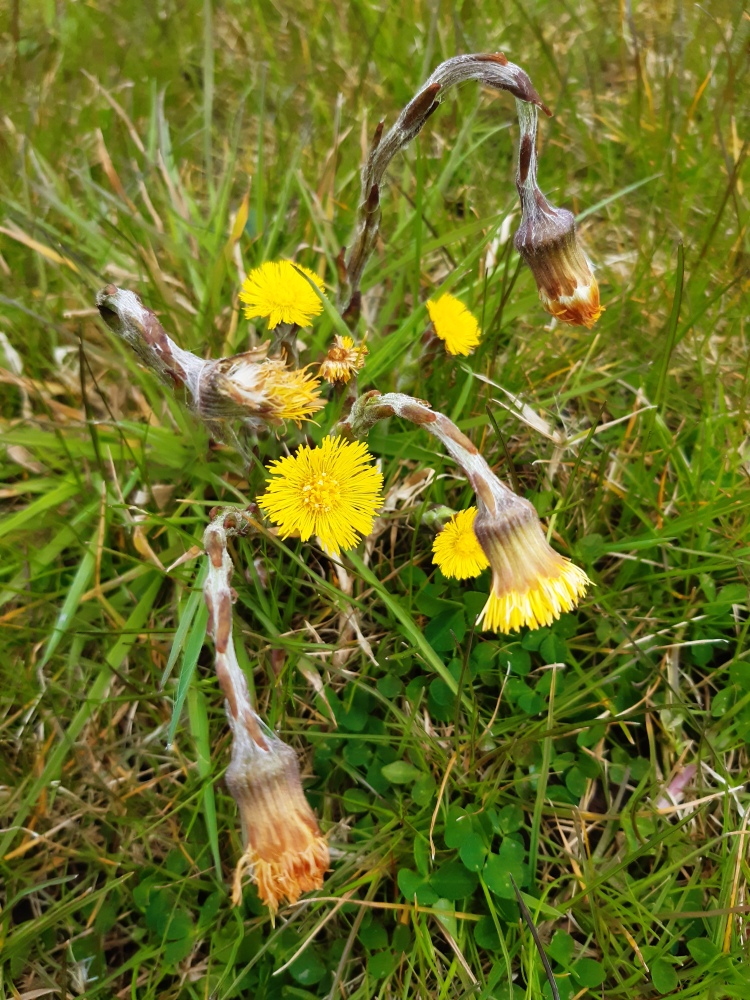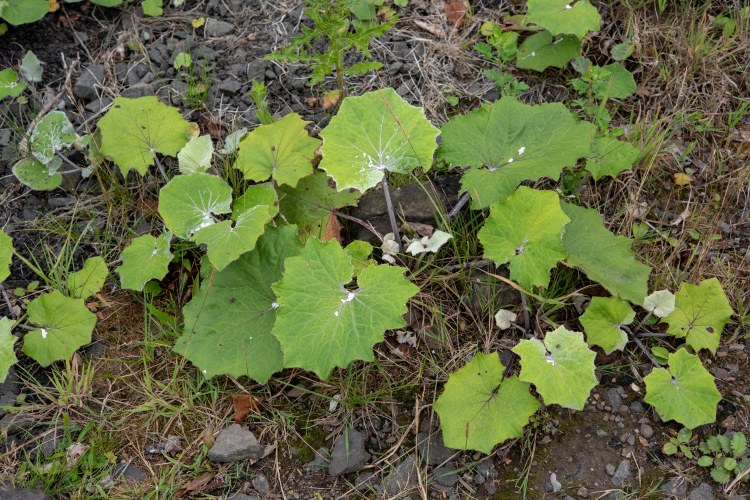
Tussilago farfara, commonly called colt’s-foot, is one of the first splashes of bright colour in spring. Its yellow flowerheads appear on otherwise bare ground and at the sides of paths from as early as March, and they flower before the plant comes into leaf.

This species is in the Asteraceae, in the Senecioneae tribe, and is the only species in its genus (although in the past several species of Petasites were included in Tussilago). Like other members of this family, the flowerheads are composed of many small flowers (florets) grouped together. The central flowers, star-shaped and tubular, are the disc florets. The outer, strap-shaped flowers that resemble petals are the ray florets and serve to attract pollinators. These flowerheads are a couple of centimetres across and are borne on erect stems clad in scales and woolly hair. The stems reach up to about 15cm.


Insects such as bees and hoverflies carry pollen from plant to plant. The pollinated flowers develop into achenes that possess a pappus: a fringe of hairs that acts like a parachute, catching the wind and dispersing the seeds. The inflorescences turn into fluffy clocks, reminiscent of dandelions.
As the flowers die off, the leaves unfurl. They are broadly triangular, with cordate bases and scalloped or lobed margins, with sometimes darker teeth. They are felty and soft on the underside, a good way to tell them apart from many Petasites, which they can resemble. They expand to reach up to 30cm across. Later in the year, they often develop orange patches of the rust Coleosporium tussilaginus underneath. This rust, interestingly, alternates hosts between Tussilago and Pinus (pines) at different stages of its lifecycle. The leaves sprout from the rhizome, with no stem present.

This is a perennial plant, which possesses a rhizome to which it dies back over winter. It also propagates vegetatively via these rhizomes, which are brittle and easily broken. It grows on disturbed ground and open areas, often in clay-rich and compacted soils. It can be found in waste ground, by paths and roadsides, on farmland, by rivers and on dunes. As such, it can tolerate coastal conditions.
It is commonly found throughout the UK and Ireland (the NBN Atlas contained 61,369 records on 24th Feb 2022!), and is native to a wide swath of Europe, Asia and North Africa. It has also been introduced to other areas, for example both North and South America, and is considered an invasive species in some of these areas.

Colt’s-foot has a long history of medicinal use for treatment of coughs, bronchitis and other respiratory problems. In Europe, the leaves were the most often used, while in traditional Chinese medicine, the flower buds (before opening) are used. The plant contains mucilage, which helps soothe inflamed tissues, though the plant also contains pyrrolizidine alkaloids, which act as liver toxins. Care needs to be taken in order to use this plant medicinally, through appropriate preparation and doses. In the past it was said that smoking the dried leaves like tobacco would help coughs and shortness of breath (though this seems a little counterintuitive!).

The name colt’s-foot likely comes from the shape of the leaves, which could be said to resemble a horse’s hoof. The generic epithet is derived from the Latin ‘tussus’ meaning to cough: a reference to its use as a cough medicine. It has a plethora of other common names to choose from, though, should you desire, such as:
- Coughwort
- Foal’s foot
- Horsehoof
- Ass’s foot
- Bull’s foot
- Farfara
- Clay weed
- Cleats
- Tushylucky
References
– First Nature, 2022. Tussilago farfara – Colt’s-foot. [online] Available at: https://www.first-nature.com/flowers/tussilago-farfara.php
– Gerard, John, 1636. Ed. Marcus Woodward. Gerard’s Herball. Bracken Books, London.
– NBN, 2021. Tussilago farfara L. [online] Available at: https://species.nbnatlas.org/species/NBNSYS0000004037
– Plantlife, 2022. Colt’s-foot. [online] Available at: https://www.plantlife.org.uk/uk/discover-wild-plants-nature/plant-fungi-species/colts-foot
– RHS, 2021. Tussilago farfara. [online] Available at: https://www.rhs.org.uk/plants/18563/tussilago-farfara/details
– Rose, Francis, 2006. The Wild Flower Key. Frederick Warne, London
– Streeter, D, Hart-Davies, C, Hardcastle, A, Cole, F & Harper, L, 2010. Collins Flower Guide. William Collins, London
– Wikipedia, 2021. Tussilago. [online] Available at: https://en.wikipedia.org/wiki/Tussilago
– text and images (unless otherwise attributed) by Heather Forbes